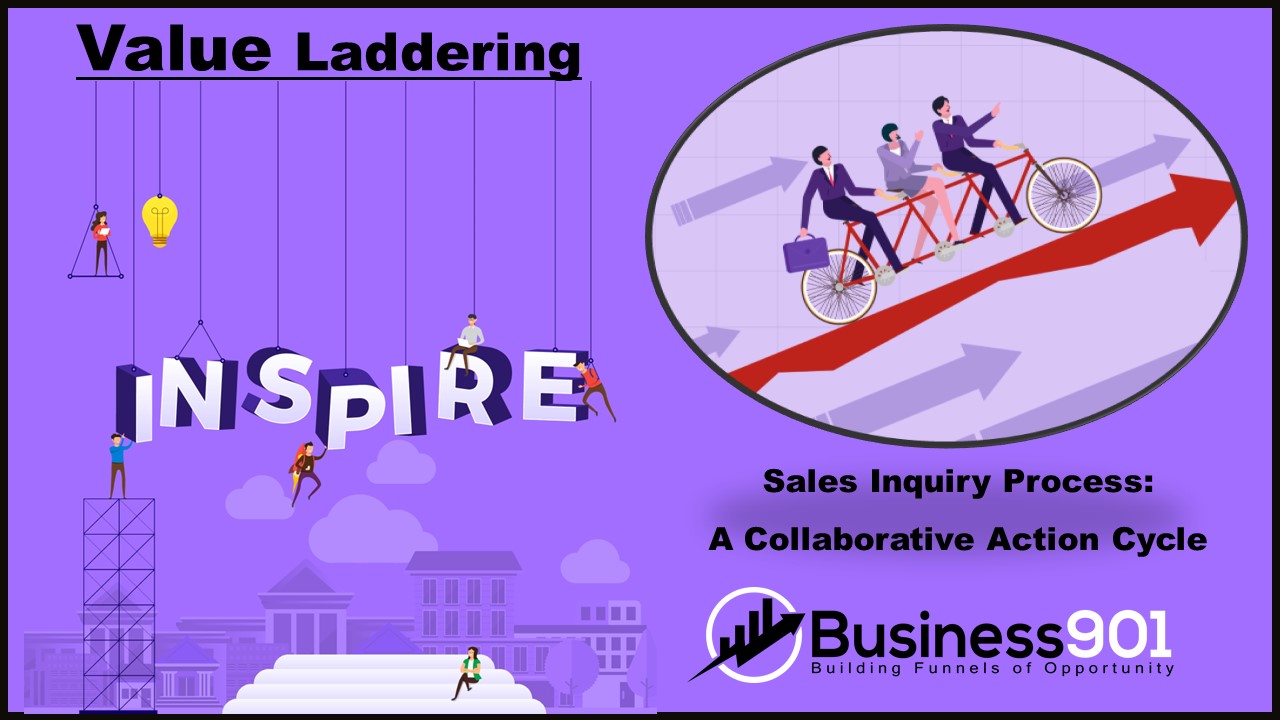An inquiry-based approach to selling is achieved when salespeople discover through Inquiry. Professional sales and business development strategies focus on communication incorrectly translating into ‘selling.’ Fortunately, there is a more effective selling method: Inquiry, Curiosity, and Agency. Salespeople discover how to create spaces that excite curiosity and encourage critical thinking in customers by leading with Inquiry. The inquiry perspective can be defined by outlining the characteristics of inquiry salespeople and then modeling the mindset. Leaders can help customers express themselves, think more deeply, and learn more effectively by bringing voice, reflection, and learning to professional development.
Overview of The Inquiry-Action Cycle: The inquiry action cycle is about humans exploring together. It’s about finding new perspectives. It’s about expanding horizons. And it’s about bringing more creative, collaborative, productive selling into the world.
Step 1: What’s the Problem: Before any customer or client has a problem, they have a goal. Typically, customers have a goal related to their business. For example, a manager could have a goal of increasing customer satisfaction. A customer service rep could have the goal of increasing employee knowledge. A salesperson could have a goal of increasing revenue. You can help your customers explore their goals by asking, “What is your goal?” The customer might respond by saying their goal is to increase revenue. You can dig deeper by asking, “How do you know when you’ve reached that goal?”
Step 2: Acceptance: When a customer or client expresses a goal, it’s important to be accepting of that goal. You don’t need to approve of the customer’s goals. You don’t even need to understand them. But you do need to accept them. While you may want to challenge your customer to think deeper or explore new perspectives, now is not the time. Now is the time for acceptance. When customers share their short-term goals, they invite you into a conversation. They’re looking for your help. They accept your offer to help them reach their goals by purchasing your product or service.
Step 3: Theory of Action: Once you’ve accepted the customer’s goals, it’s time to encourage the customer to theorize about their goals. You can ask questions like, “Why do you want to increase revenue?” or, “Why do you want to increase customer satisfaction?” You can also ask questions like, “What prevents you from reaching your goal?” or, “What would need to change for you to reach your goal?” You might even want to ask, “What if we could find a way to reach your goal but do something different? What if we could find a better way of reaching your goal?”
Step 4: Taking Action: You may notice the customer shifting as you encourage the customer to theorize about their goals. As this happens, you can gently steer the customer toward taking action. You can ask, “What would you like to do next?” or, “What’s the next step you can take toward reaching your goal?” You might ask, “What are you excited to start doing right now?” or, “What is your next most important action?”
Step 5: Evaluation: As the customer takes action, they’ll also start to evaluate their progress. They’ll have successes and failures. They’ll be able to compare their progress with their expectations. When this happens, you can ask, “How are you doing?” or “How are you progressing toward your goal?” You can ask, “What has been helpful?” or, “What has not been helpful?” It’s important to be non-judgmental as the customer evaluates their progress. You do not need to critique their progress or offer feedback. You can ask, “What are you noticing?” or, “What has been helpful?”
Step 6: Reflection: When the customer is done taking action, they’ll want to reflect on their progress. They’ll want to learn from their successes and failures. They’ll want to explore where they went wrong and how they could do better next time. As the customer reflects, you can ask, “What are you noticing?” or, “How are you reflecting on the progress you’ve made?” You can also ask, “What would you like to learn from your progress?” Listening to your customer’s reflections allows them to open up and share more deeply. You can ask, “What are you most interested in exploring?”
Putting the Inquiry-Action Cycle in Practice: At each stage of the inquiry action cycle, you can ask yourself the following questions to ensure you’re engaging in the process appropriately. – What are you hearing? – What are you seeing? – What are you feeling? – What are you thinking? If you’re engaging in the cycle appropriately, it should feel like you’re having a conversation with your customer. You should be reading their body language and listening to their words. If you’re engaging in the cycle appropriately, you should feel like you’re collaborating with your customer. You should feel like you’re working together toward a common goal. If you’re engaging in the cycle appropriately, you should be able to create a record of the conversation. You should be able to write down thoughts and feelings in the cycle. You can use this record to reflect and learn from your inquiry sales conversations.
Conclusion: The inquiry action cycle is about humans exploring together. It’s about finding new perspectives. It’s about expanding horizons. And it’s about bringing more creative, collaborative, productive selling into the world.
The inquiry information is based on the reading and outlines provided in the following books:
Leading with a Lens of Inquiry: Cultivating Conditions for Curiosity and Empowering Agency Paperback – May 25, 2022 by Jessica Vance (Amazon Affiliate Link: https://amzn.to/3ABjmEp)
Leading With Inquiry and Action: How Principals Improve Teaching and Learning 1st Edition by Matthew C. Militello (Author), Sharon F Rallis (Author), Ellen B. Goldring (Author) (Amazon Affiliate Link: https://amzn.to/3pkQ3iV)

